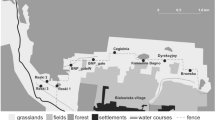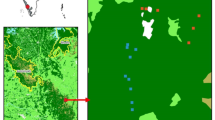Abstract
In the Amazon region diurnal line-transect census is the technique used by most monitoring programs to collect data on medium and large terrestrial mammals. However, this method usually fails to provide high quality information (e.g. abundance, occurrence) for some species, especially for larger bodied and less abundant ones, which are mostly threatened by human disturbances. Aiming to provide guidelines for monitoring programs in the region we compared the efficiency of three field techniques: (1) diurnal surveys (i.e. diurnal line-transect census with sign surveys), (2) nocturnal surveys and (3) camera trapping in non-flooded and seasonally flooded forest sites at the Uacari Sustainable Development Reserve, western Brazilian Amazonia. Nocturnal surveys provided poor information for all species, except pacas. Tracks accounted for 50% of the observations recorded during diurnal surveys, the most effective technique for smaller diurnal species and ungulates. For armadillos and rare species camera trapping was the most effective technique. Moreover, all techniques failed to detect the most common species, agouti, in at least two sites. High sampling effort using a combination of sampling methods and statistical analyses that enable the integration of different source data, such as photos, tracks and visual sightings, are necessary steps to maximize the efficiency of medium and large mammals monitoring programs in Amazonian forests.
Similar content being viewed by others
References
Azad, M., 2006. Mammal diversity and conservation in a secondary forest in Peninsular Malaysia. Biodivers. Conserv. 15, 1013–1025.
Azevedo-Ramos, C., do Amaral, B.D., Nepstad, D.C., Soares, B., Nasi, R., 2006. Integrating ecosystem management, protected areas, and mammal conservation in the Brazilian Amazon. Ecol. Soc., 11.
Beck-King, H., von Helversen, O., Beck-King, R., 1999. Home range, population density, and food resources of Agouti paca (Rodentia: Agoutidae) in Costa Rica: a study using alternative methods. Biotropica 31, 675–685.
Boddicker, M., Rodriguez, J.J., Amanzo, J., 2002. Indices for assessment and monitoring of large mammals within an adaptive management framework. Environ. Monit. Assess. 76, 105–123.
Bodmer, R.E., Eisenberg, J.F., Redford, K.H., 1997. Hunting and the likelihood of extinction of Amazonian mammals. Conserv. Biol. 11, 460–466.
Brashares, J.S., Sam, M.K., 2005. How much is enough? Estimating the minimum sampling required for effective monitoring of African reserves. Biodivers. Conserv. 14, 2709–2722.
Buckland, S.T., Anderson, D.R., Burnham, K.P., Laake, J.L., Borchers, D.L., Thomas, L., 2001. Introduction to Distance Sampling: Estimating Abundance of Biological Populations. Oxford University Press, New York.
Carrillo, E., Wong, G., Cuaron, A.D., 2000. Monitoring mammal populations in Costa Rican protected areas under different hunting restrictions. Conserv. Biol. 14, 1580–1591.
Danielsen, F., Burgess, N.D., Balmford, A., 2005. Monitoring matters: examining the potential of locally-based approaches. Biodivers. Conserv. 14, 2507–2542.
Danielsen, F., Balete, D.S., Poulsen, M.K., Enghoff, M., Nozawa, C.M., Jensen, A.E., 2000. A simple system for monitoring biodiversity in protected areas of a developing country. Biodivers. Conserv. 9, 1671–1705.
Danielsen, F., Burgess, N.D., Balmford, A., Donald, P.F., Funder, M., Jones, J.P.G., Alviola, P., Balete, D.S., Blomley, T., Brashares, J., et al., 2009. Local participation in natural resource monitoring: a characterization of approaches. Conserv. Biol. 23, 31–42.
de Thoisy, B., Brosse, S., Dubois, M.A., 2008. Assessment of large-vertebrate species richness and relative abundance in neotropical forest using line-transect censuses: what is the minimal effort required? Biodivers. Conserv. 17, 2627–2644.
Dirzo, R., Miranda, A., 1990. Contemporary neotropical defaunation and forest structure, function, and diversity—a sequel. Conserv. Biol. 4, 444–447.
Dubost, G., 1988. Ecology and social life of the red acouchy, Myoprocta exilis; comparison with the orange-rumped agouti, Dasyprocta leporina. J. Zool. (Lond.) 214, 107–123.
Ferraz, G., Marinelli, C.E., Lovejoy, T.E., 2008. Biological monitoring in the Amazon: recent progress and future needs. Biotropica 40, 7–10.
Gomez, H., Wallace, R.B., Ayala, G., Tejada, R., 2005. Dry season activity periods of some Amazonian mammals. Stud. Neotrop. Fauna Environ. 40, 91–95.
Haugaasen, T., Peres, C.A., 2005a. Mammal assemblage structure in Amazonian flooded and unflooded forests. J. Trop. Ecol. 21, 133–145.
Haugaasen, T., Peres, C.A., 2005b. Primate assemblage structure in Amazonian flooded and unflooded forests. Am. J. Primatol. 67, 243–258.
Henry, P.Y., Lengyel, S., Nowicki, P., Julliard, R., Clobert, J., Celik, T., Gruber, B., Schmeller, D., Babij, V., Henle, K., 2008. Integrating ongoing biodiversity monitoring: potential benefits and methods. Biodivers. Conserv. 17, 3357–3382.
Hill, K., Padwe, J., Bejyvagi, C., Bepurangi, A., Jakugi, F., Tykuarangi, R., Tykuarangi, T., 1997. Impact of hunting on large vertebrates in the Mbaracayu reserve, Paraguay. Conserv. Biol. 11, 1339–1353.
Hines, J.E., 2006. PRESENCE 2—software to estimate patch occupancy and related parameters. USGS-PWRC (www.mbr-pwrc.usgs.gov/software/presence.html).
Jerozolimski, A., Peres, C.A., 2003. Bringing home the biggest bacon: a cross-site analysis of the structure of hunter-kill profiles in neotropical forests. Biol. Conserv. 111, 415–425.
Jorge, M., 2008. Effects of forest fragmentation on two sister genera of Amazonian rodents (Myoprocta acouchy and Dasyprocta leporina). Biol. Conserv. 141, 617–623.
Karanth, K.U., 1995. Estimating Panthera tigris populations from camera-trap data using capture-recapture models. Biol. Conserv. 71, 333–338.
Lopes, M.A., Ferrari, S.F., 2000. Effects of human colonization on the abundance and diversity of mammals in eastern Brazilian Amazonia. Conserv. Biol. 14, 1658–1665.
MacKenzie, D.I., 2005. What are the issues with presence-absence data for wildlife managers? J. Wildl. Manage. 69, 849–860.
MacKenzie, D.I., Nichols, J.D., Lachman, G.B., Droege, S., Royle, J.A., Langtimm, C.A., 2002. Estimating site occupancy rates when detection probabilities are less than one. Ecology 83, 2248–2255.
Martins, S.D., Sanderson, J.G., Silva-Junior, J.D.E., 2007. Monitoring mammals in the Caxiuanu National Forest, Brazil—first results from the tropical ecology, assessment and monitoring (TEAM) program. Biodivers. Conserv. 16, 857–870.
Michalski, F., Peres, C.A., 2007. Disturbance-mediated mammal persistence and abundance-area relationships in Amazonian forest fragments. Conserv. Biol. 21, 1626–1640.
Milner-Gulland, E.J., Bennett, E.L., 2003. Wild meat: the bigger picture. Trends Ecol. Evol. 18, 351–357.
Naughton-Treves, L., Mena, J.L., Treves, A., Alvarez, N., Radeloff, V.C., 2003. Wildlife survival beyond park boundaries: the impact ofslash-and-burn agriculture and hunting on mammals in Tambopata. Peru. Conserv. Biol. 17, 1106–1117.
Nichols, J.D., Williams, B.K., 2006. Monitoring for conservation. Trends Ecol. Evol. 21, 668–673.
Norris, D., Peres, C.A., Michalski, F., Hinchsliffe, K., 2008. Terrestrial mammal responses to edges in Amazonian forest patches: a study based on track stations. Mammalia 72, 15–23.
Noss, A.J., Oetting, I., Cuellar, R., 2005. Hunter self-monitoring by the Isoseno-Guarani in the Bolivian Chaco. Biodivers. Conserv. 14, 2679–2693.
Pardini, R., Ditt, E.H., Cullen, L., Bassi, C., Rudran, R., 2003. Levantamento rápido de mamíferos terrestres de médio e grande porte. In: Cullen Jr., Rudran, R., Padua, C.V. (Eds.), Métodos de Estudo em Biologia da Conservação e no Manejo da Vida Silvestre. Editora da Universidade Federal do Paraná, Curitiba, pp. 181–201.
Parry, L., Barlow, J., Peres, C.A., 2007. Large-vertebrate assemblages of primary and secondary forests in the Brazilian Amazon. J. Trop. Ecol. 23, 653–662.
Peres, C.A., 1996. Population status of white-lipped Tayassu pecari and collared peccaries T. tajacu in hunted and unhunted Amazonian forests. Biol. Conserv. 77, 115–123.
Peres, C.A., 1997. Primate community structure at twenty western Amazonian flooded and unflooded forests. J. Trop. Ecol. 13, 381–405.
Peres, C.A., 1999. General guidelines for standardizing line-transect surveys of tropical forest primates. Neotrop. Primates 7, 11–16.
Peres, C.A., Palacios, E., 2007. Basin-wide effects of game harvest on vertebrate population densities in Amazonian forests: implications for animal-mediated seed dispersal. Biotropica 39, 304–315.
Plumptre, A.J., 2000. Monitoring mammal populations with line transect techniques in African forests. J. Appl. Ecol. 37, 356–368.
Pollock, K.H., Nichols, J.D., Simons, T.R., Farnsworth, G.L., Bailey, L.L., Sauer, J.R., 2002. Large scale wildlife monitoring studies: statistical methods for design and analysis. Environmetrics 13, 105–119.
Pontes, A.R.M., 2004. Ecology of a community of mammals in a seasonally dry forest in Roraima, Brazilian Amazon. Mamm. Biol. 69, 319–336.
Reyna-Hurtado, R., Tanner, G.W., 2007. Ungulate relative abundance in hunted and non-hunted sites in Calakmul Forest (Southern Mexico). Biodivers. Conserv. 16, 743–756.
Royle, J.A., Nichols, J.D., 2003. Estimating abundance from repeated presence-absence data or point counts. Ecology 84, 777–790.
Schwarz, C.J., Seber, G.A.F., 1999. Estimating animal abundance: review III. Stat. Sci. 14, 427–456.
Silver, S.C., Ostro, L.E.T., Marsh, L.K., Maffei, L., Noss, A.J., Kelly, M.J., Wallace, R.B., Gomez, H., Ayala, G., 2004. The use of camera traps for estimating jaguar Panthera onca abundance and density using capture/recapture analysis. Oryx 38, 148–154.
Soares, B.S., Nepstad, D.C., Curran, L.M., Cerqueira, G.C., Garcia, R.A., Ramos, C.A., Voll, E., McDonald, A., Lefebvre, P., Schlesinger, P., 2006. Modelling conservation in the Amazon basin. Nature 440, 520–523.
Stoner, K.E., Riba-Hernandez, P., Vulinec, K., Lambert, J.E., 2007. The role of mammals in creating and modifying seedshadows in tropical forests and some possible consequences of their elimination. Biotropica 39, 316–327.
Tobler, M.W., Carrillo-Percastegui, S.E., Powell, G., 2009. Habitat use, activity patterns and use of mineral licks by five species of ungulate in south-eastern Peru. J. Trop. Ecol. 25, 261–270.
Tobler, M.W., Carrillo-Percastegui, S.E., Pitman, R.L., Mares, R., Powell, G., 2008. An evaluation of camera traps for inventorying large- and medium-sized terrestrial rainforest mammals. Anim. Conserv. 11, 169–178.
Voss, R.S., Emmons, L.H., 1996. Mammalian diversity in neotropical lowland rainforests: a preliminary assessment. Bull. Am. Mus. Nat. Hist. 230, 3–115.
Wegge, P., Storaas, T., 2009. Sampling tiger ungulate prey by the distance method: lessons learned in Bardia National Park. Nepal Anim. Conserv. 12, 78–84.
Williams, B.K., Nichols, J.D., Conroy, M.J., 2002. Analysis and Management of Animal Populations. Academic Press, San Diego, CA.
Yoccoz, N.G., Nichols, J.D., Boulinier, T., 2001. Monitoring of biological diversity in space and time. Trends Ecol. Evol. 16, 446–453.
Author information
Authors and Affiliations
Corresponding author
Rights and permissions
About this article
Cite this article
Munari, D.P., Keller, C. & Venticinque, E.M. An evaluation of field techniques for monitoring terrestrial mammal populations in Amazonia. Mamm Biol 76, 401–408 (2011). https://doi.org/10.1016/j.mambio.2011.02.007
Received:
Accepted:
Published:
Issue Date:
DOI: https://doi.org/10.1016/j.mambio.2011.02.007




